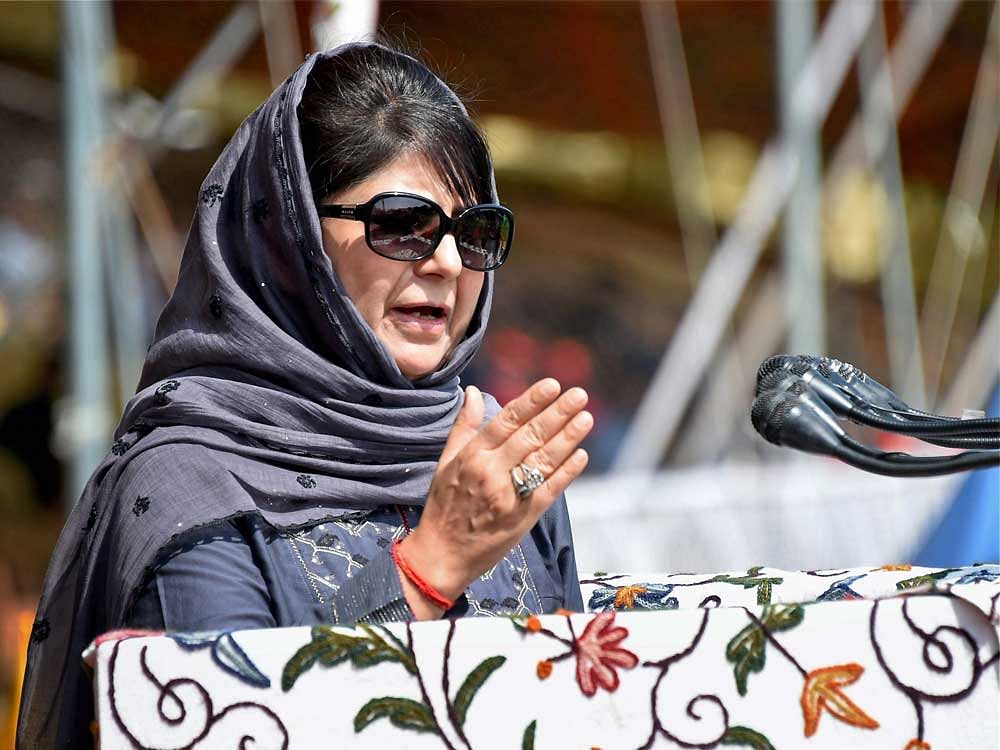J&K heads for Guv's rule 8th time in last 41 yrs
Last Updated IST

Mehbooba Mufti. PTI file photo
As the more than three-year-old alliance between the BJP and the PDP ended in Jammu and Kashmir on Tuesday, the state is heading for governor’s rule for the eighth time in more than four decades.
]
Ironically, on the seven previous occasions, PDP founder and outgoing Chief Minister Mehbooba Mufti's father, the late Mufti Mohammad Sayeed, was an important player in the political developments that led to the imposition of central rule.
The governor’s rule was imposed in the state first time on March 26, 1977, when the Congress, then headed by the late Mufti, withdrew support to National Conference (NC) government led by the late Sheikh Abdullah. After the Indira-Sheikh Accord in 1975, the NC had formed the government with the support of Congress. However, after Congress withdrew support, the assembly was dissolved. L K Jha took over as the governor for three months.
In July 1984, Sheikh Abdullah’s son-in-law, Ghulam Muhammad Shah, toppled the then chief minister, Farooq Abdullah, with the help of 26 Congress members and 12 NC "defectors". But, in March 1986, the Congress, again headed by the late Mufti, withdrew support to Shah government, paving the way for another spell of governor’s rule.
The governor’s rule was imposed for the third time on January 19, 1990, when armed insurgency broke out and Farooq-led NC government resigned in protest against the appointment of Jagmohan as the governor for the second time. The late Mufti was the Union Home Minister at that time and had brushed aside Abdullah's opposition to Jagmohan's appointment.
Eruption of militancy
Governor's rule continued till October 1996 when assembly elections were held for the first time after the eruption of militancy. The state also went for a brief stint of Governor's rule for two weeks from October 18, 2002, after Farooq Abdullah had asked the then Governor G C Saxena to relieve him of caretaker Chief Ministership as PDP, then headed by the late Mufti, and Congress were taking time in cobbling up numbers to form the government.
Governor’s rule was again imposed in the state on July 8, 2008, following the resignation of the then CM, Ghulam Nabi Azad, after he failed to prove majority support in the Legislative Assembly when PDP, headed by the late Mufti, withdrew support to the Congress.
Governor's rule was imposed for the sixth time after the assembly election results on December 23, 2014 threw up a hung assembly with no party or combination of parties being able to stake a claim to form the government and Omar Abdullah, the caretaker CM, asking to be relieved from the duties with immediate effect on January 7.
The central rule ended after the PDP and the BJP stitched an alliance paving the way for the return of the late Mufti as CM on March 1, 2015. When Governor's rule was imposed for the seventh time in 2016 after Mufti’s death on January 7, 2016, Omar Abdullah had said the imposition of Governor's rule during Vohra's tenure (for the third time) “must be a record in itself.”
Mufti dies
Mufti's death was the cause for the last promulgation of the central rule on January 8, 2016 after allies-- PDP and BJP-- deferred the government formation process till the end of the four-day mourning period.
Governor’s rule is imposed in Jammu and Kashmir under Section 92 (1) of the State Constitution with the approval of the President of India. While in rest of the states in the country President's rule is imposed under Article 356 of the Constitution in the event of failure of constitutional machinery, in case of Jammu and Kashmir, governor's rule for a period of six months is imposed after the proclamation is issued by the governor. The State Assembly is either kept in suspended animation or dissolved.
President’s rule can be imposed under Article 356 of the Constitution in Jammu and Kashmir if the Constitutional machinery is not restored before the expiry of six months period.